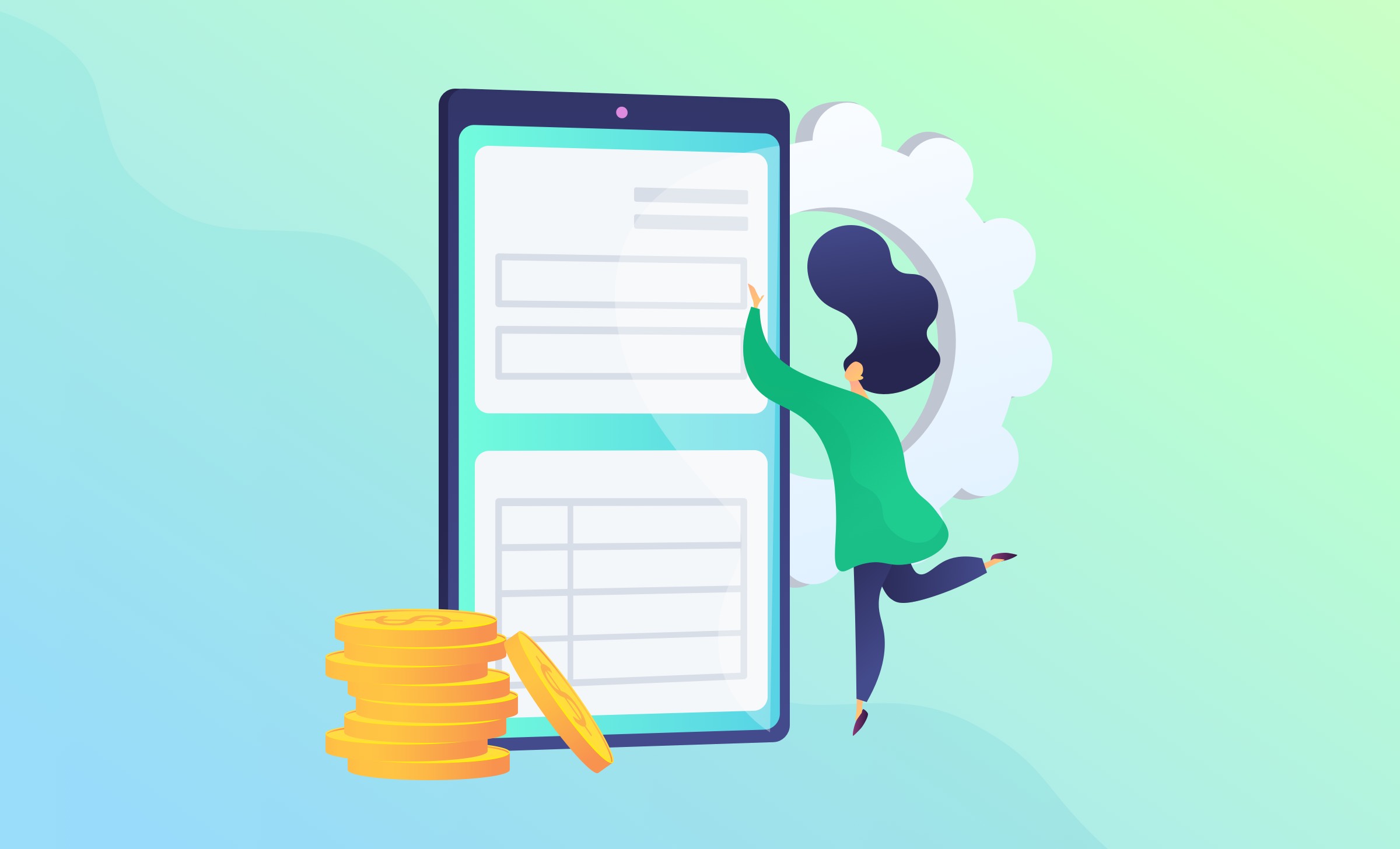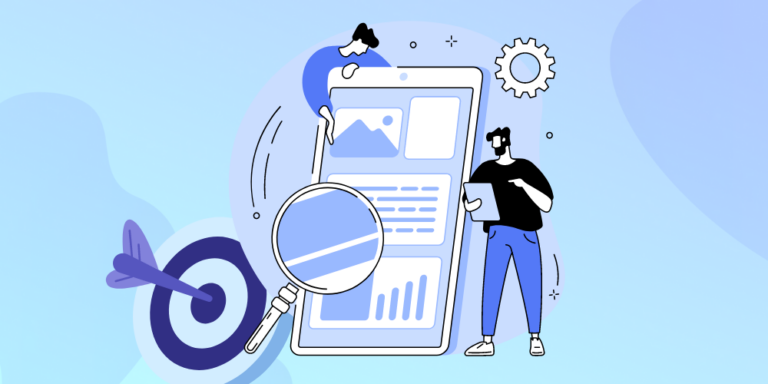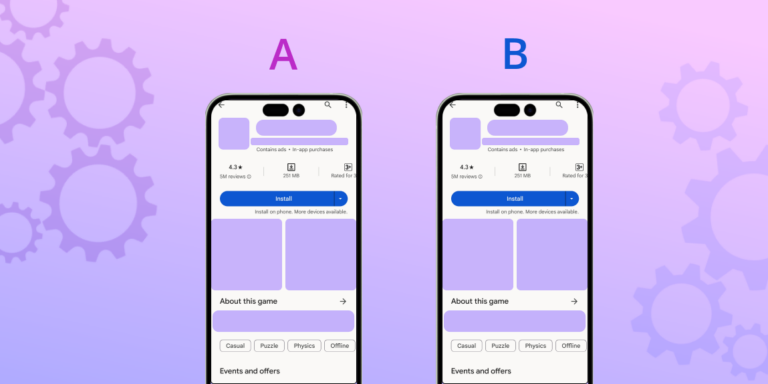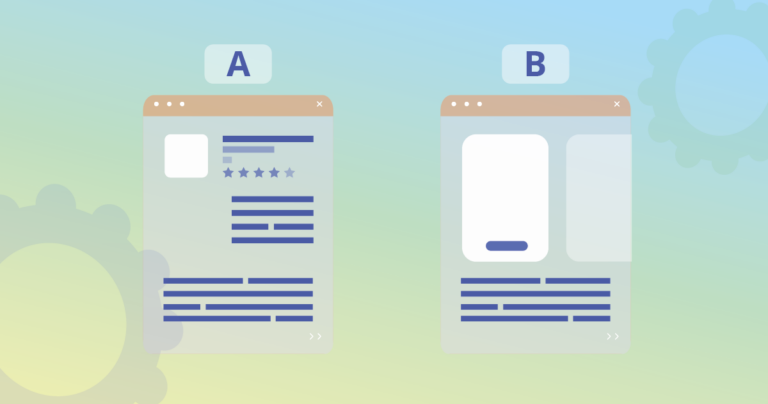Any marketplace charges certain fees for listing your products on their sites. Percentages, rates, and levels differ on the basis of a particular place and sometimes cause dissatisfaction among developers (just recall the large-scale rumble of Apple and Epic Games regarding the Google Play and App Store fee. While some titles are pretty famous and self-sufficient now, they might not have achieved such success without marketplaces.
The amount that software devs and publishers share may differ according to the particular spot. However, despite being direct competitors, Play Market and App Store, the industry giants, get the same percentage of fees. In fact, they’re only slightly different in terms of content. Many creators build universal products that are available on both main platforms.
Table of Contents
In this post, we will get a closer look at:
- how the leading platforms make money by hosting your games and apps;
- and also compare their approaches to calculating platform fees;
- additionally, we’ll let you in on how to give Apple App Store and Google Play store less money, fee-wise;
- we’ll briefly touch upon the instances when making a mistake in pricing equals ‘eating into your reputation and profits’ (Katharine Paine, founder and CEO of KDPaine & Partners);
- furthermore, our experts will also try themselves as fortune tellers, attempting to predict the future of Google Play and App Store fee dynamics;
- last but not least, we’ll answer some of your most frequently asked questions about Android and iOS app store fees.
In addition to realizing how the major tech giants work, you also should know there are many other services that can publish your titles. We’ll touch upon this topic in today’s post, too. Stay tuned.
How Do Google Play Store and Apple App Store Make Money?
To understand how the earnings of large sites are formed, you should understand what exactly they are. A marketplace is a service that does not sell its own products. It serves as a place where creators can put their products. That is, they can be considered hubs that collect services or goods from different manufacturers.
Such platforms have many advantages for creators. Thanks to them, you get traffic and convenient tools for managing it, so you do not need to spend money, time, and other resources to attract customers, as, for example, you need to do with your own store or website. Moreover, buyers tend to trust large providers more, especially if various products (different types of applications and games for every taste) can be bought in one place. So, marketplaces can be seen as a profitable alternative to a website.
Since such platforms do not produce or sell anything themselves, how do they make money? The answer is an app store commission for every sale you perform. Moreover, depending on your annual turnover and the monetization scheme, the percentage may differ. Aspiring software devs are known to raise the issue of high fees regularly. In 2021, the environment became so tense that major providers were forced to change the percentage and make it more reasonable.
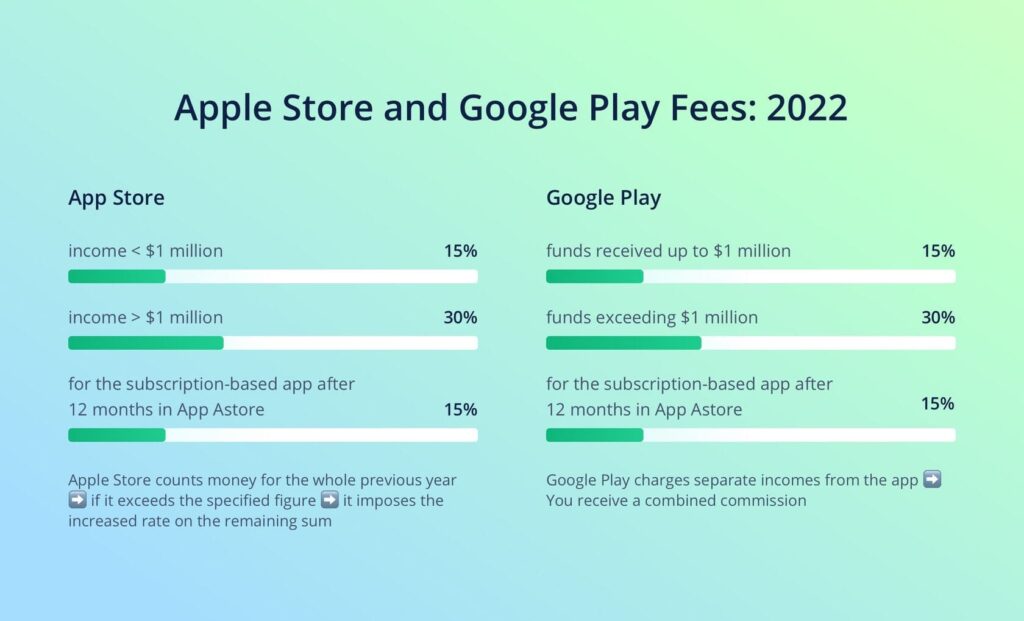
Despite the devs’ and publishers’ dissatisfaction with Google and Apple’s monthly charges, they still continue to place their titles on Apple Store and Play Market since they’re the default marketplaces for almost all portable devices. And if big players like Epic Games can afford to go against the rules and sell their products on their own resources, small businesses cannot take that step.
What Is an App Store Fee and How Is It This Calculated
Now let’s move on to the main issue. What are platform fees exactly? Since your games and apps are hosted on major marketplaces, you have to share some of your profits. At the same time, there is a clear division according to the types of income you generate:
- Paid services. Here everything is very clear. For each user’s transaction and app installation, a piece of your income is submitted to the markets. The same principle works here as with any other reseller. They collect the fee for advertising and promoting you within the platform.
- IAPs. In this case, we mean investments that a client can make through your application. Fees are based on the amounts you receive. And while there is a temptation not to implement IAPs to avoid paying marketplace fees, their importance should be underestimated. For details on how to utilize these items to promote apps, see our dedicated article “In-App Purchases: Increase Your Product Visibility in App Stores.”
- Subscriptions. A similar principle works with subscriptions as with IAPs. You’ll have to pay a set percentage to digital stores for each membership renewal.
The Google and Apple in-app purchase commission doesn’t apply to you if buyers receive physical goods through your apps. That is, if you utilize your product as an e-commerce tool and sell something that, after payment, will be delivered to customers in the hands, you will not have to share such income. Also, if you cooperate with promotion networks, place advertisements for third-party services in your apps and games, and receive payments, such income is not subject to commission.
All app store payments from your users should go through digital stores’ payment systems. Customers cannot pay directly to your account to purchase products. At the same time, you do not receive this money immediately on the day of transactions but after some time. The same is true for deductions from your profits. The amount of regular deductions in favor of marketplaces directly depends on your income. Deadlines and minimum thresholds vary by site.
Google Play And App Store Fee
Just like ASO and SEO, these two marketplaces set the tone for the entire industry. And although they are major rivals, they cannot change (increase or decrease) commission fees without checking each other’s revenue. This is exactly what happened in 2021 when Apple revised its terms for listing products in its store, and sometime later, Google was forced to do the same. So, how do Google Play and Apple Store charge publishers and creators?
App Store
Does Apple charge for apps? Yes, before these global changes, the marketplace adhered to the standard Apple 30 percent cut. This high percentage still exists, too, but it only applies to creators whose income exceeds $1 million (your earnings from the previous year are considered when calculating the amount). Such popular services can be counted on the fingers since most devs get much lower net profits.
How much does the App Store take from smaller companies? As part of its support for small companies, novice developers, and start-ups, the company offered a reduced rate of 15%. It applies to those whose income is lower than $1 million. Also, even top Apple Store apps can qualify for a lowered fee if their buyers have renewed a subscription for a year or more (only the time during which users actually paid for membership is taken into account; trials are not counted). As per the tech giant’s representatives and Sensor Tower experts, around 98% of all publishers and devs can claim a reduced rate.
Does Apple charge tax on in-app purchases? Yes, the greater part of these items is subject to fees. The only exceptions are physical products your customers can order through your software. That is, buyers get the ordered goods in their hands. All other transactions are subject to 15% and 30% deductions.
Always remember about the so-called “developer fee,” which you should provide annually if you wish to get a paid account. The enterprise version has a higher cost. Fortunately, this amount is flat and does not depend on how many applications you publish or how many IAPs you add.
Google Play
If you already have an Android app submission, it’s time to learn about the Google Play fees. The Google app store fees have a progressive tax rate. If you get income below $1 million (like most other devs), 15% is taken from you. Following Apple, the company introduced a 12-month membership threshold, after which any products, including top Google Play apps, receive a reduced rate. However, your percentage will remain high if you are not enrolled in the creator assistance program. The commission does not apply to advertising profit and the sale of physical items.
How does Google Play charge you? The main difference between this store and a competitor is how the profit threshold works. The thing is, you may get a combined commission. All funds received up to $1 million are liable to 15%, and the rest exceeding this threshold is subject to 30%. Apple counts money for the whole previous year, and if it exceeds the specified figure, it imposes the increased rate on the remaining sum. It seems this approach is more loyal and sparing for developers. According to Google representatives, the reduced percentage applies to 99% of publishers since the income of most creators does not exceed $1 million.
You should also add a one-time (non-recurring) compensation for opening a developer profile to these deductions. By the way, all publishers and creators pay the same amount, regardless of the agency size. There are no other annual fees.
Interesting Fact. Back in 2020, a multitude of app developers (Spotify and Netflix being among them) united and filed a lawsuit against Google’s App Store. The lawsuit revolved around Google’s App Store’s 30% ‘monopoly fee’ leaving no room for healthy competition. Three years later, Google reached settlement in the US Play Store lawsuit, promising developers more freedom. As a matter of fact, that lawsuit against Google’s monopolizing ways was not the first one, and the legal fight itself was really intense.
Other stores fees
Of course, Play Market and Apple’s Store are the largest names in the industry, and the guidelines and requirements they publish are usually considered first. Despite their dominance in the industry, there are other marketplaces where you have the opportunity to list your products. Let’s take a quick look at their fees:
- Amazon: 30% off products and IAPs, games, and other software, and 20% off movies and memberships.
- Samsung Galaxy: 30% off all items unless otherwise specified.
- Microsoft Store: 30% on games, IAPs, business and education accounts, 15% on other items, and a non-recurring payment for opening a publisher profile.
- Aptoid (Google Play analog): 25% for certified creators.
- LG SmartWorld: 30% for all products and developers.
- Huawei: 20% for educational services, 30% for non-game IAPs and paid downloads, and 50% for game IAPs.
- MIUI (service for Xiaomi gadgets): 50% for games and 30% exclusive for Tencent products (2019 and newer).
By and large, all other platforms provide the opportunity to publish apps and games designed for Android. Apple gadgets only work with products downloaded from the branded store.
App Store Fees: How They Impact Small Developers vs. Big Players
Developers of all sizes embark on a financial quest and have to face the mighty tolls levied by Apple and Google. From the indie artisans to the colossal corporations, the impact of these fees varies, creating a digital tapestry of challenges and triumphs. Let’s take a closer look at this topic below.
- The indie underdogs
Indies, the Davids of the digital world, sling code instead of stones. For indie developers, App Store fees can be a weighty burden, slicing a significant chunk from their modest earnings. Every penny counts, and these developers often feel the sting more keenly. - Mid-range mavericks
Neither Goliath nor David, the mid-range developers are like Goldilocks, seeking fees that are just right. Mid-sized developers navigate a balancing act. The fees are felt, but they often have more resources to absorb the blow, allowing them to focus on growth without feeling completely dwarfed. - Corporate giants
The Goliaths, where slinging cash is as mighty as slinging code. For large corporations, the fees are more like a toll booth on the highway—they slow down but rarely halt the journey. The impact is there, but it’s often a minor speed bump in the grand scheme of their expansive financial landscapes. - The dreamers and experimenters
These dreamers are coding away in hope, experimenting in the digital laboratory. For those experiment lovers, the fees may seem like a wizard’s toll to the unknown. Yet, the hope is that the magical results outweigh the mystical costs.
How to Keep More Apples in Your Basket
Ah, the Apple App Store — a digital haven for all things app-related, but alas, not without its tolls. If you’ve ever dreamt of a cunning escape plan to keep more of your hard-earned cash from landing in Apple’s coffers, you’re not alone. Fear not, intrepid app-reneur. Below, we’ve provided a guide with tips on how to give Apple’s App Store less money while still playing by its rules.
- Bundle up (your apps, not just yourself)
Bundle your apps together like a warm winter wardrobe, but more profitable. Why? Because Apple’s recent allowance for app bundling can save you a pretty penny. Instead of paying individual tolls for each app, create bundles that give users more and cost you less. - Play the promo game
Be the puppet master of promotions, not just another player. How? Utilize Apple’s promotional tools, as well as Asolytics pro tools, to make your app stand out without bleeding your budget. Whether it’s a temporary price drop or a limited-time free offer, play the promo game strategically. It will boost your downloads without sacrificing your profits.
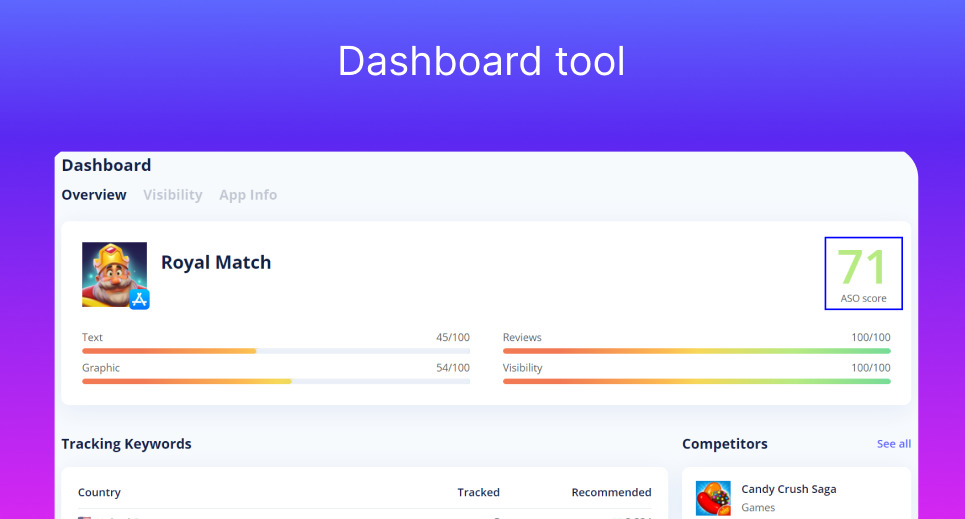
Track your app’s visibility score using the Dashboard
- Go cross-platform, like an app explorer
Become the digital Lewis and Clark. The App Store is not the only digital frontier. Explore cross-platform distribution. Yes, the App Store is undeniably shiny and tempting. However, you should consider spreading your app seeds to other platforms where fees might be more forgiving. - Embrace the (slightly) old-fashioned
Sometimes, old tech is like vintage wine — still good and cheaper. Opt for older payment methods like credit cards instead of in-app purchases. It may not be as flashy as the latest trends, but it might just save you a percentage or two.
How to Give Google Play Store Less Money
Google Play Store is where apps frolic and users roam. Yet, amidst the digital dance, there’s the unavoidable matter of fees. If you’re yearning for a strategy to keep more of your app-generated revenue away from the Google coffers, worry not. Below, we’ve provided some useful tips on how to outwit the system and give Google Play Store less of your hard-earned finances.
- Time your sales right
Be a deal maestro, not just another app peddler. Plan your app sales strategically. Capitalize on seasonal events, holidays, or special occasions to attract users without the sting of the full Play Store fee. Analyze your competitors via Asolytics to make informed decisions within your strategy.
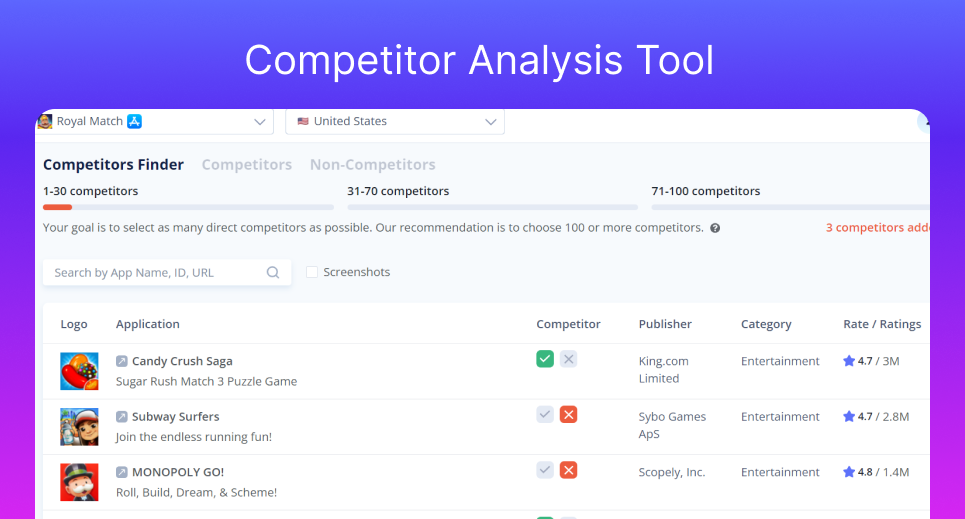
Use the Competitors tool in Asolytics to find all the similar apps in your niche
- Exploit in-app advertising
Turn the tables and let your app make Google pay (for a change). Make the most of in-app advertising to offset costs. While users enjoy your app, advertisers foot part of the bill, leaving you with more financial padding. - Be mindful of regional pricing
Think globally, price locally. Like money values change in different countries, adjust your app’s price based on where people live. This makes your app more attractive to users and might mean you pay fewer fees in some places. - Embrace third-party payment systems
Dance with partners outside the Google ballroom. They might have cheaper dance floors. In other words, consider alternative payment methods. Embracing third-party systems can bypass some of Google’s fees, offering you a financial waltz with fewer deductions.
Crack the Crystal Ball: What’s the Future of App Store Fees?
The future of app store fees seems ripe for transformation. A lot of factors contribute to what’s next in the world of app store payments. Industry trends, regulatory whispers, and the rise of futuristic tech are guaranteed to make an impact. So, let us grab our crystal ball and delve into the potential changes on the horizon.
- Regulatory winds of change
The regulators might become the unsung heroes, saving app developers from fee fiestas. With increasing scrutiny on tech giants, regulatory bodies could influence a fairer fee structure, which will contribute to a more balanced playground for app devs. - Industry trends: the rise of alternatives
Like fashion trends, app developers might start donning alternative distribution platforms. App devs are on the constant lookout for extended freedom and flexibility. Therefore, alternative platforms may gain popularity, pressuring major players to reevaluate their fee structures to retain their digital darlings. - Tech marvels: decentralized solutions
Blockchain and decentralization could be the superheroes swooping in, capes billowing. Emerging technologies like blockchain might introduce decentralized app distribution, which will potentially reshape fee dynamics and grant developers newfound independence. - Subscription dominance
App fees may take on a Netflix vibe, with subscriptions ruling the digital roost. Now that the subscription model is gaining traction, app store fees might shift towards subscription-based structures. This will potentially offer developers and users a different financial dance.
If you want your app to succeed in the future, make sure you know what ASO cannibalism is and how to avoid it.
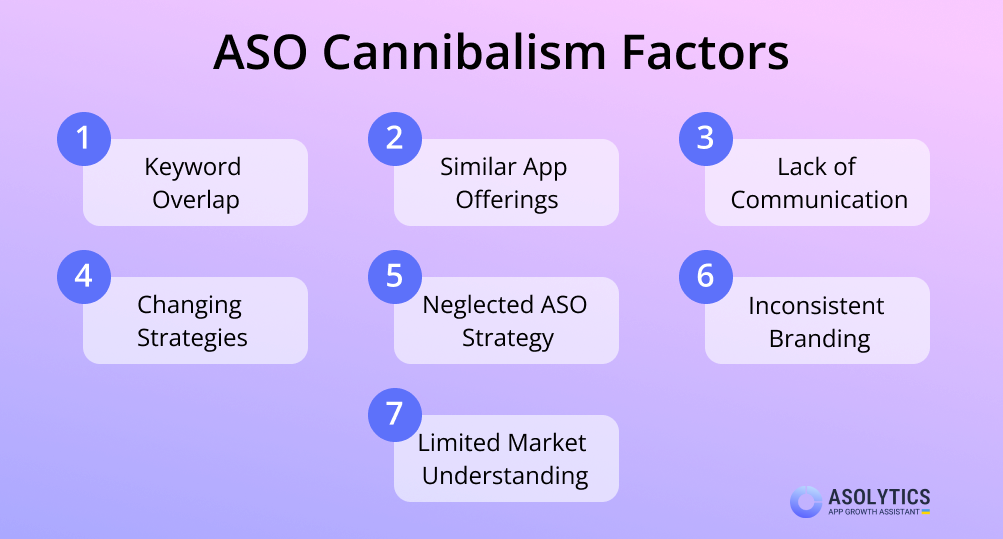
Summing up the App Store Fee Overview
Commissions, interests, and fees are an integral part of the app building process. Whether developers like it or not, they have to put up with it. As you can see, industry leaders have largely the same requirements:
- the reduced rate of 15% on income below $1 million and subscribers paying within 12 months;
- the standard rate of 30% on profits above $1 million.
The difference is that Google calculates the fee based on all of your earnings from the previous year. On the other hand, Apple offers a more loyal policy: income up to the threshold is subject to the reduced rate, and everything above this threshold is subject to the standardized rate. Also, each provider has certain fees for opening a creator account.
When placing games and applications, you should comply with the guidelines of a specific marketplace and be prepared for mandatory commissions. These costs are extremely important to consider when calculating the final cost of your product, memberships, and IAPs. They are added to all other expenses you have to deal with as a creator or publisher.
FAQ
What are the app store fees for developers on Google Play Store and Apple App Store?
Apple App Store and Google Play Store developer fee usually comes down to 15-30% of an app’s earnings. It’s like a small fee for the VIP ticket to the app world — it covers the glitzy entrance, the security guards, and the digital red carpet.
Can the fees vary for different types of transactions?
Absolutely! It’s like a menu with different prices. For in-app purchases and app downloads, Google Play Store and Apple App Store usually charge their fees — usually 15-30%. It’s like paying a little extra for dessert or choosing the deluxe package for your digital goodies. Different transactions, different fees, but all part of the app feast!
Are there any exceptions or discounts for indie developers or small businesses?
Yes, there’s hope for the little guys! Both Google Play Store and Apple App Store offer some discounts and exceptions for indie developers and small businesses. It’s like a small-business discount at your favorite store, making it a bit easier for the underdogs to shine in the digital marketplace. To check app store fees for free apps, head to the official website of the chosen platform.
How often are App Store fees charged to developers?
Google Play Store and Apple App Store usually charge these fees on an annual basis.
Do the App Store fees cover additional services?
Absolutely! Think of the Google Play Store yearly fee as your app’s VIP pass. It covers not only the basic entrance but also the fancy services like app reviews and security. It’s like paying for a premium party package — your app gets the red carpet treatment. It’s not just present but also the star of the digital show!
Are there any penalties or additional fees for apps that generate higher revenue?
No penalties, just a digital high-five! While there aren’t specific penalties for apps hitting the revenue jackpot, the app store fees may take a slightly larger slice. Think of it like upgrading from a regular to a deluxe pizza — the toppings (fees) increase as your app becomes more of a digital feast.
Can developers offer promotions or discounts without impacting the app store fees?
Yes, they can. The outcome is so appealing: users are happy, while you as a developer still get to keep the cake (read as earnings) intact. Win-win for everyone!
Are there differences in fees for educational or non-profit apps?
Educational or non-profit apps get the VIP treatment. Some app stores offer reduced fees or exemptions for these do-gooder apps. It’s like a special lane on the digital highway for apps with a heart. Check the Apple App Store and Google Play Store fees for free apps, and your altruistic app might enjoy a smoother financial journey.
Do the fees differ for subscription-based apps compared to one-time purchase apps?
Yes, they do! It’s like picking a different dance floor. For subscription-based apps, both Google Play Store and Apple App Store usually charge a bit less — around 15-30% — compared to one-time purchase apps. The tip? Consider the dance moves your app wants to make (read as its user engagement and revenue goals), and then choose the pricing strategy that lets it groove smoothly in the digital ballroom.
Can I sell physical goods/services via my app without extra charges?
This one is a slippery slope, actually. Selling physical goods is basically setting a mini-shop within your app. It means that you can be charged additional fees for this endeavor. That said, always check your play store’s terms in advance if you want to avoid unexpected spendings.
How do I avoid app store fees?
Unfortunately, you cannot avoid app store fees completely. But as a wise developer, you can always distribute your app(s) via alternative platforms. By making the most of this tip, you can find options with less fees and more freedom.
Can I negotiate app store fees for my unique business model?
Give it a shot! Alas, app store fees aren’t the most flexible. But it doesn’t hurt to inquire. Larger developers or unique business models may actually find some wiggle room. Contact the app store’s support or business team and channel your inner negotiator.
Can I get a refund for my Apple App Store or Google Play Store commission fee if my app doesn’t perform well?
No luck on the refund front! App store fees, once paid, are like tickets to a show — non-refundable. Therefore, you should go the extra mile when planning your strategies and do your best to take your product’s performance to the next level.
Can app store fees be tax-deductible for my business?
Tax deduction, the silver lining! While not a guaranteed deduction, app store fees might qualify as a business expense. It’s like finding a digital loophole in the tax maze. Consult a tax professional. Think of it as a little financial wizardry to sprinkle some savings onto your business books.
How often do Apple App Store and Google Play Store developer account fee structures change?
Like a software update, app store fees evolve periodically. It’s not a daily disco, but industry trends and regulations might prompt changes. Keep your digital ears perked for platform announcements, updates, and/or policies. This will assist you in adjusting your strategy accordingly.

